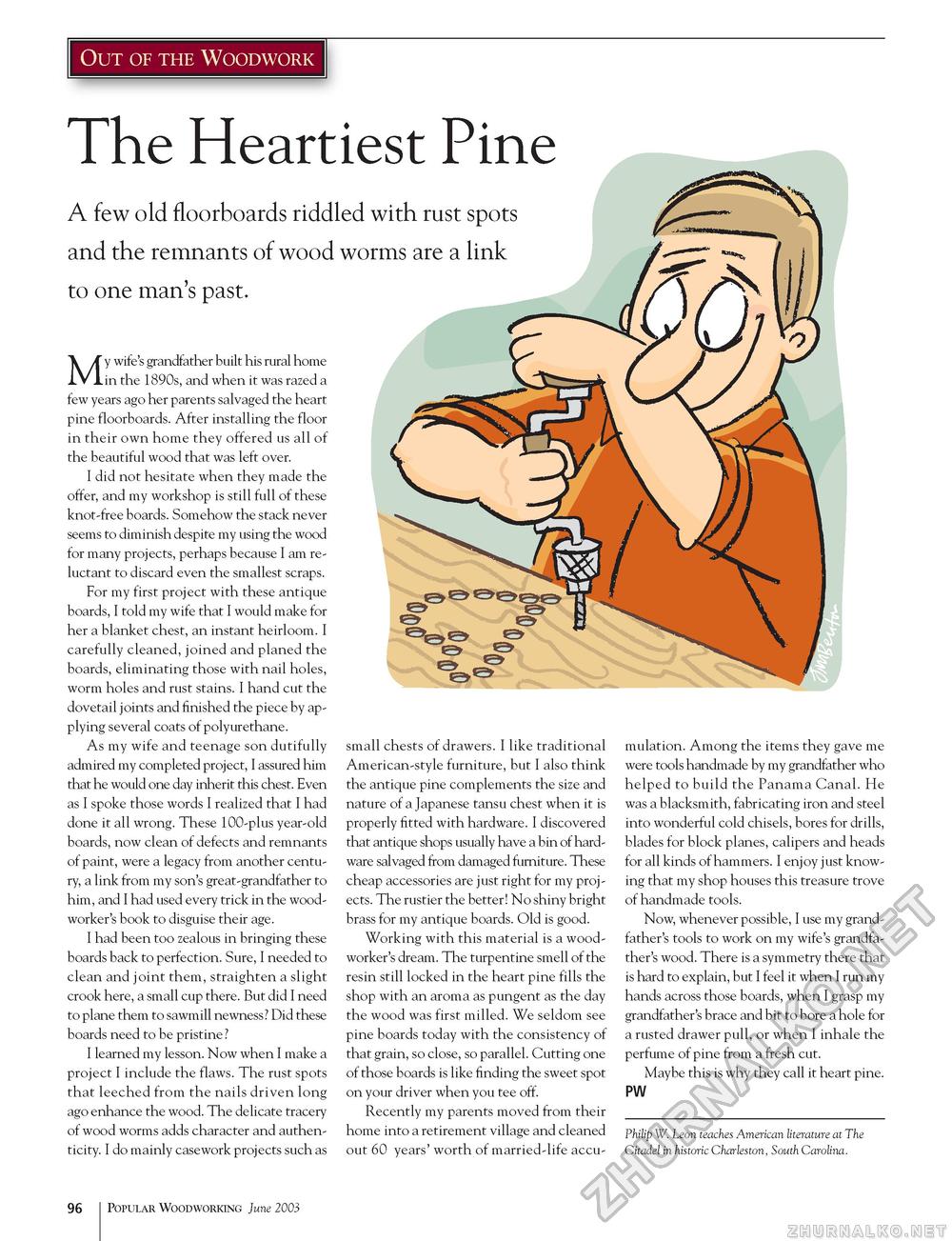Popular Woodworking 2003-06 № 134, страница 98
Out of the Woodwork The Heartiest Pine A few old floorboards riddled with rust spots and the remnants of wood worms are a link to one man's past. My wife's grandfather built his rural home in the 1890s, and when it was razed a few years ago her parents salvaged the heart pine floorboards. After installing the floor in their own home they offered us all of the beautiful wood that was left over. I did not hesitate when they made the offer, and my workshop is still full of these knot-free boards. Somehow the stack never seems to diminish despite my using the wood for many projects, perhaps because I am reluctant to discard even the smallest scraps. For my first project with these antique boards, I told my wife that I would make for her a blanket chest, an instant heirloom. I carefully cleaned, joined and planed the boards, eliminating those with nail holes, worm holes and rust stains. I hand cut the dovetail joints and finished the piece by applying several coats of polyurethane. As my wife and teenage son dutifully admired my completed project, I assured him that he would one day inherit this chest. Even as I spoke those words I realized that I had done it all wrong. These 100-plus year-old boards, now clean of defects and remnants of paint, were a legacy from another century, a link from my son's great-grandfather to him, and I had used every trick in the woodworker's book to disguise their age. I had been too zealous in bringing these boards back to perfection. Sure, I needed to clean and joint them, straighten a slight crook here, a small cup there. But did I need to plane them to sawmill newness? Did these boards need to be pristine? I learned my lesson. Now when I make a project I include the flaws. The rust spots that leeched from the nails driven long ago enhance the wood. The delicate tracery of wood worms adds character and authenticity. I do mainly casework projects such as small chests of drawers. I like traditional American-style furniture, but I also think the antique pine complements the size and nature of a Japanese tansu chest when it is properly fitted with hardware. I discovered that antique shops usually have a bin of hardware salvaged from damaged furniture. These cheap accessories are just right for my projects. The rustier the better! No shiny bright brass for my antique boards. Old is good. Working with this material is a woodworker's dream. The turpentine smell of the resin still locked in the heart pine fills the shop with an aroma as pungent as the day the wood was first milled. We seldom see pine boards today with the consistency of that grain, so close, so parallel. Cutting one of those boards is like finding the sweet spot on your driver when you tee off. Recently my parents moved from their home into a retirement village and cleaned out 60 years' worth of married-life accu mulation. Among the items they gave me were tools handmade by my grandfather who helped to build the Panama Canal. He was a blacksmith, fabricating iron and steel into wonderful cold chisels, bores for drills, blades for block planes, calipers and heads for all kinds of hammers. I enjoy just knowing that my shop houses this treasure trove of handmade tools. Now, whenever possible, I use my grandfather's tools to work on my wife's grandfather's wood. There is a symmetry there that is hard to explain, but I feel it when I run my hands across those boards, when I grasp my grandfather's brace and bit to bore a hole for a rusted drawer pull, or when I inhale the perfume of pine from a fresh cut. Maybe this is why they call it heart pine. PW Philip W. Leon teaches American literature at The Citadel in historic Charleston, South Carolina. 96 Popular Woodworking June 2003 |







